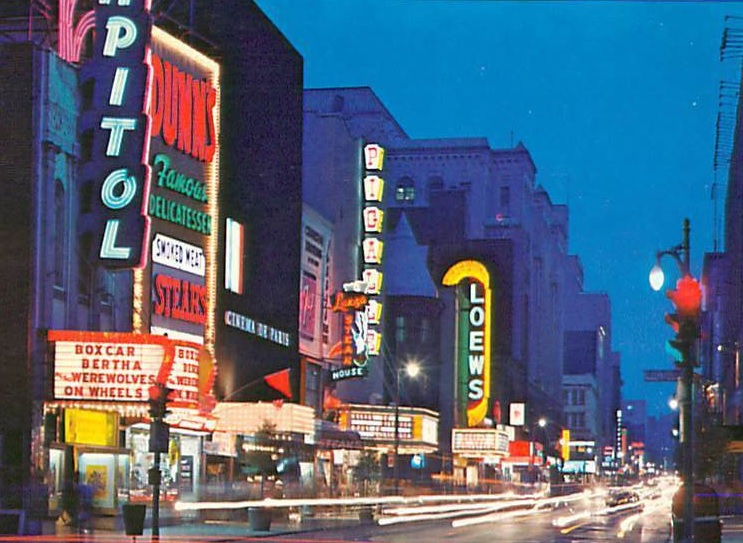Montréal, Québec / December 11, 1966
|
On Dec. 11, 1966, a 17-year-old was released from prison on a day pass to visit his family in preparation for his parole scheduled for December 24. He and an 18-year-old former convict spent several hours drinking in East End Montréal bars after which they hailed a taxi driven by Arthur Desjardins at the corner of St. Catherine and Clark streets in the heart of Montréal's notorious Red Light District. Mr. Desjardins was about 48 years old. The pair attacked Mr. Desjardins near Clark and Vitre streets, beating him so badly with a .22 calibre pistol that the plastic handgrip was shattered. The 17-year-old then shot the taxi driver to death with a single gunshot to the head and robbed him of $28. The taxi was found at the intersection about 11:30 p.m. with the headlights on and the engine running. A door was wide open and the bullet had gone through the windshield. Mr. Desjardins was slumped over the steering wheel. After killing Mr. Desjardins the pair held up a motorist at gunpoint and robbed him of $1.25. The motorist gave descriptions to the police who quickly tracked down the 18-year-old. The 17-year-old was picked up at the Berthelet Correctional Centre where he had quietly returned to await his forthcoming parole. The 17-year-old was charged with capital murder and the prosecution asked for the death penalty, but since capital punishment did not apply to offenders under 18 years of age he was sentenced to life imprisonment. Beginning in 1971 he was given temporary leaves to visit his family, but parole was refused in 1974. On August 15, 1974 the killer, now 24, was given a weekend pass but he failed to return on August 18. On November 2 he teamed up with two other young men to rob a Montréal restaurant. When Dr. Gaston Perrault tried to intervene the killer shot him in cold blood. The killer also fatally wounded a pursuing police officer, Constable Aimé Pelletier, as the trio fled the restaurant. While still at large he sent a 16-page "open letter" to the Montréal Star blaming the justice system for turning him into a murderer. He excused the murders of Dr. Perrault ("He should have known that a citizen should not intervene during an armed robbery") and Constable Pelletier ("It was either him or me") and referred to Mr. Desjardins ("My first murder") simply as "a taxi driver". Of Mr. Desjardins the killer wrote, "It was following this drinking bout that I killed a taxi driver. I was really drunk and so was my accomplice. I didn't want to kill anyone and when I woke up in the morning I thought perhaps I had not killed anyone because I wasn't sure that the taxi driver had been hit by the shots." A month after the restaurant murders the killer committed suicide. Meanwhile, the 18-year-old was admitted to the Pinet Psychiatric Institute at Saint-Vincent-de-Paul penitentiary after what appeared to be a suicide attempt. Despite being considered "violent" and "very" dangerous," he managed to walk out of the hospital undetected a little after 1 a.m. on July 8, 1971. [Next column] |

St. Catherine Street in 1972 judging by the double bill on the Capitol Theatre marquee: Boxcar Bertha, 1972 and Werewolves on Wheels, 1971. (Source: "St. Catherine St. at Night Montréal, Canada" (detail). Photo by Marty Sheffer. Mastichrome postcard published by Benjamin-Montreal News, via Hippostcard.) Two hours later police spotted him and arrested him at gunpoint after a foot chase. He was still at the Pinet Institute two years later, on June 11, 1973, when he escaped again. This time he and an accomplice took three staff members hostage. The accomplice, who had murdered a fellow inmate a year earlier, suffered from the delusion that he was Lawrence of Arabia. Apparently the killer chose him as an accomplice because he was easy to manipulate. The killer persuaded the accomplice to keep the hostages under guard while he himself made his escape. With the hostages still in the power of a violent and unstable inmate, the authorities were forced to let the killer go. Eventually the accomplice was persuaded to exchange the hostages for a car and a head start. He was allowed to drive a couple of blocks before police trapped and captured him. The killer remained at large for a week before police found him. When he tried to run they shot him in the foot. Although wounded he tried to seek refuge in a nearby apartment block. When he pleaded with a woman to open the locked door because his life was in danger, she told him to call the police instead. |

 • Driver Profiles
• Driver Profiles